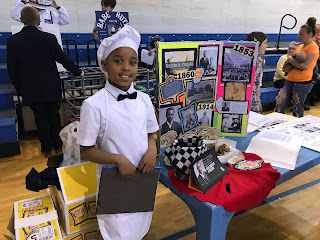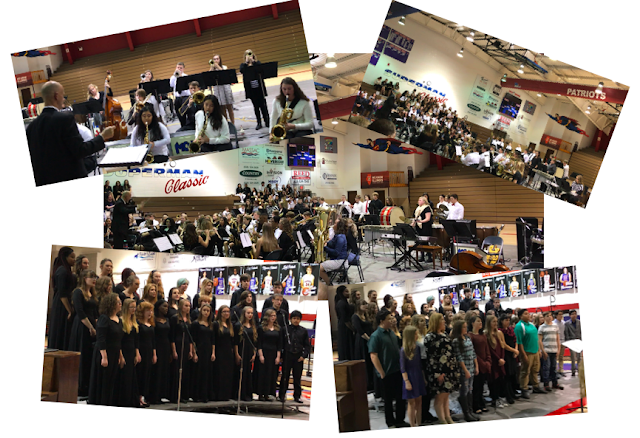Spring Spotlight #1
The Living Wax Museum
 I was invited to Metropolis Elementary School last week to view the 4th grade students' Living Wax Museum. I had never heard of anything exactly like this before and made it a point to attend. When I arrived, I found all the fourth grade students lined up around the gym posing as famous Americans. Each student had a display of facts about their person, and most were dressed in costumes to appear as their historical figure did when they were alive. The students were also describing their historical figure's achievements in first person to all the visitors as we walked around this living museum. These displays and re-enactments were quite impressive. I met everyone from George Crum to Susan B. Anthony in the gym that morning. Students from other grade levels were also allowed to visit the museum and learn about these individuals from these fourth grade students. I even saw several parents visiting and learning from these students.
I was invited to Metropolis Elementary School last week to view the 4th grade students' Living Wax Museum. I had never heard of anything exactly like this before and made it a point to attend. When I arrived, I found all the fourth grade students lined up around the gym posing as famous Americans. Each student had a display of facts about their person, and most were dressed in costumes to appear as their historical figure did when they were alive. The students were also describing their historical figure's achievements in first person to all the visitors as we walked around this living museum. These displays and re-enactments were quite impressive. I met everyone from George Crum to Susan B. Anthony in the gym that morning. Students from other grade levels were also allowed to visit the museum and learn about these individuals from these fourth grade students. I even saw several parents visiting and learning from these students.
I asked the fourth grade teachers about this project and how it worked, one teacher shared this with me:
Another teacher approached the project slightly differently:
Above all, this is one of those activities that these students will always remember. The administrative team has interviewed over ten applicants over the last few weeks. At least half of these applicants are local Massac graduates. When asked about why they decided to become a teacher, many of them have referenced something that they experienced in our very own elementary schools. We heard examples from Mrs. Rushing's and Mr. Speck's classes at Jefferson, and Mrs. Sawyer's class at Unity. Someday in the future, one of these students may sit in an interview for a teaching position and recall this project as one of the reasons that they decided to be a teacher.
 I was invited to Metropolis Elementary School last week to view the 4th grade students' Living Wax Museum. I had never heard of anything exactly like this before and made it a point to attend. When I arrived, I found all the fourth grade students lined up around the gym posing as famous Americans. Each student had a display of facts about their person, and most were dressed in costumes to appear as their historical figure did when they were alive. The students were also describing their historical figure's achievements in first person to all the visitors as we walked around this living museum. These displays and re-enactments were quite impressive. I met everyone from George Crum to Susan B. Anthony in the gym that morning. Students from other grade levels were also allowed to visit the museum and learn about these individuals from these fourth grade students. I even saw several parents visiting and learning from these students.
I was invited to Metropolis Elementary School last week to view the 4th grade students' Living Wax Museum. I had never heard of anything exactly like this before and made it a point to attend. When I arrived, I found all the fourth grade students lined up around the gym posing as famous Americans. Each student had a display of facts about their person, and most were dressed in costumes to appear as their historical figure did when they were alive. The students were also describing their historical figure's achievements in first person to all the visitors as we walked around this living museum. These displays and re-enactments were quite impressive. I met everyone from George Crum to Susan B. Anthony in the gym that morning. Students from other grade levels were also allowed to visit the museum and learn about these individuals from these fourth grade students. I even saw several parents visiting and learning from these students. I asked the fourth grade teachers about this project and how it worked, one teacher shared this with me:
This is the first time we have done this particular project. We had been looking for something where the kids would take ownership for the research and their learning. They were allowed to select their famous person which helped get them invested. I think we all three approached the project a tad bit differently. We started the project after Spring Break. I spent the first day having the kids view and understand the difference in .gov .org .com sites and that some aren't reliable. After this, we spent the next 7 days during Social Studies using guiding questions for them to each find answers. Then we used the next couple days with them writing their speeches. I had other students assist the students that needed extra help and then I helped them write a picture speech. The next 2-3 days was spent using Google Doc for them to learn how to type the information for their poster and copy/paste pictures for their poster. We had a great time, but also found ways we might change it for next year.
Another teacher approached the project slightly differently:
As you can see from these examples, all three teachers used their own style to teach the same skills to the entire grade level. This is a good example of the variance that we welcome in our classrooms. We strive to eliminate variance in what we are teaching students so that every student learns the same skills as the progress through our unit district and funnel into one junior high and high school. However, we encourage variance in how we teach these same skills because everybody learns in a way that is somewhat unique. Methods that work for some students do not work at all for others. This project was a great example of student learning from many different perspectives. I observed fully engaged students, students taking charge of their learning, individual creativity, using technology to create rather than drill and practice, learning on the analysis and synthesis levels of Bloom's taxonomy, rubric-based assessment, and many other instructional best practices.The students worked very hard and took ownership of the entire project. In my classroom, the students selected their person prior to Spring Break and did a short fact page to spark their interest and get them started. After Spring Break, the students received their note card packet to complete, and given a due date of April 23rd. The students had to complete the note card packet, complete a poster (which was shared with our class during their classroom speech and was a part of the Living Museum), as well as prepare and give a 2-3 minute speech/presentation to our class. We spent at least 40 minutes a day researching as a class (I gave them a list of 10 sites to look for information, and told them they could use other sites as well) and more time if we could get a laptop cart. I also gave students the option of coming into class during their lunch break to work on research. Several that didn't have internet access at home took advantage of this opportunity. We researched for approximately 2 weeks. The week before the project was due we spent two afternoons working on posters. April 24-26th my students gave their presentations in front of our class. The project culminated with the Living Museum on April 27th. Overall, the project was a success. The students learned how to research and find information, as well as compile and use the information, all skills they will need as they move forward in their school careers. My students really enjoyed learning about not only their famous American, but about their classmate's as well. They enjoyed it so much that they've voted to tackle a state research project this month and are currently in the process of selecting which state they will be researching about and presenting to our class.
Above all, this is one of those activities that these students will always remember. The administrative team has interviewed over ten applicants over the last few weeks. At least half of these applicants are local Massac graduates. When asked about why they decided to become a teacher, many of them have referenced something that they experienced in our very own elementary schools. We heard examples from Mrs. Rushing's and Mr. Speck's classes at Jefferson, and Mrs. Sawyer's class at Unity. Someday in the future, one of these students may sit in an interview for a teaching position and recall this project as one of the reasons that they decided to be a teacher.












Comments
Post a Comment